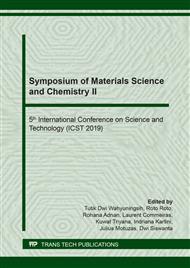[1]
P.J.P. Espitia, W.X. Du, R.J. Avenna-Bustillos, N.F.F. Soares, T.H. McHugh, Edible films from pectin: physical-mechanical and antimicrobial properties, Food Hydrocoll. 35 (2014) 287-296.
DOI: 10.1016/j.foodhyd.2013.06.005
Google Scholar
[2]
P. Sriamornsak, Chemistry of pectin and its pharmaceutical uses: a review, Silapkorn Univ. Int. J. 3 (2003) 206-228.
Google Scholar
[3]
K.R.F. Muruci de Paula, L.Lopes da Silva, Applications of pectin: a multipurpose of biomolecule, Austin Biomol. Open Access 1 (2016) 1-2.
Google Scholar
[4]
L.S. Liu, M.L. Fishman, K.B. Hicks, Pectin in controlled drug delivery-a review, Cellulose 14 (2007) 15-24.
Google Scholar
[5]
C. Xue, Y. Chen, Y. Huang, P. Zhu, Hydrothermal synthesis and biocompatibility study of highly crystalline carbonated hydroxyapatite nanorods, Nanoscale Res. Lett. 316 (2015) 1-6.
DOI: 10.1186/s11671-015-1018-9
Google Scholar
[6]
N.F. Mohammad, R. Othman, N.A. Abdullah, F.Y. Yeoh, In vitro evaluation of mesoporous carbonated hydroxyapatite in MC3T3-E1 osteoblast cells, Procedia Chem. 19 (2016) 259-266.
DOI: 10.1016/j.proche.2016.03.103
Google Scholar
[7]
S. Padilla, I.I. Barba, M.V. Reigi, High specific surface area in nanometric carbonated hydroxyapatite, Chem. Mater. 20 (2008) 5942-5944.
DOI: 10.1021/cm801626k
Google Scholar
[8]
Y.J. Guo, Y.Y. Wang, T. Chen, Y.T. Wei, L.F. Chu, Y.P. Guo, Hollow carbonated hydroxyapatite microspheres with mesoporous structure: hydrothermal fabrication and drug delivery property, Mater. Sci. Eng. C Mater. Biol. Appl. 33 (2013) 3166-3172.
DOI: 10.1016/j.msec.2013.03.040
Google Scholar
[9]
S. Rakmae, Y. Ruksakulpiwat, W. Sutapun, N. Suppakarn, Effect of silane coupling agent treated bovine bone based carbonated hydroxyapatite on in vitro degradation behavior and bioactivity of PLA composites, Mater. Sci. Eng. C Mater. Biol. Appl. 32 (2012) 1428-1436.
DOI: 10.1016/j.msec.2012.04.022
Google Scholar
[10]
M.K. Narbat, F. Orang, M.S. Hashtjin, A. Goudarzi, Fabrication of porous hydroxyapatite-gelatin composite scaffolds for bone tissue engineering, Iran. Biomed. J. 10 (2006) 215-223.
Google Scholar
[11]
S.N. Ashakirin, M. Tripathy, U.K. Patil, A.B.A. Majeed, Chemistry and bioactivity of cinnamaldehyde: a natural molecule of medicinal importance, Int. J. Pharm. Sci. Res. 8 (2017) 2333-2340.
Google Scholar
[12]
S.K. Wirawan, A. Prasetya, Effect of plasticizer on the pectinic edible film characteristics, Reaktor 14 (2012) 61-67.
Google Scholar
[13]
L.M. Bonnaillie, H. Zhang, S. Akkurt, K.L. Yam, P.M. Tomasula, Casein films: the affects of formulation, environmental conditions and the addition of citric pectin on the structure and mechanical properties, Polymers 6 (2014) 2018-2036.
DOI: 10.3390/polym6072018
Google Scholar
[14]
F.L. Seixas, F.R.B. Turbiani, P.G. Salomao, R.P. Souza, M.N. Gimenes, Biofilms composed of alginate and pectin: effect of concentration of crosslinker and plastisizer agents, Chem. Eng. Trans. 32 (2013) 1693-1698.
Google Scholar
[15]
Z. Li, D. Zhu, J. Yin, Y. Liu, F. Yao, K. Yao, Formation of nano-hydroxyapatite crystal in situ in chitosan-pectin polyelectrolyte complex network, Mater. Sci. Eng. C Mater. Biol. Appl. 30 (2010) 795-803.
DOI: 10.1016/j.msec.2010.03.011
Google Scholar
[16]
D. Verma, K.S Katti, D.R. Katti, B. Mohanty, Mechanical response and multilevel structure of biomimetic hydroxyapatite/polygalacturonic/chitosan nanocomposites, Mater. Sci. Eng. C Mater. Biol. Appl. 28 (2008) 399-405.
DOI: 10.1016/j.msec.2007.04.026
Google Scholar
[17]
E.F. Morgan, D.N. Yetkinler, B.R. Constantz, R.H. Dauskardt, Mechanical properties of carbonate apatite bone mineral subsitute: strength, fracture and fatigue behaviour, J. Mater. Sci. Mater. Med. 8 (1997) 559-570.
Google Scholar
[18]
Q.X. Zhu, W.H. Jiang, C. Shao, Y. Bao, Thermophysical and mechanical properties of carbonated hydroxyapatite, Key Eng. Mater. 512-515 (2012) 989-993.
DOI: 10.4028/www.scientific.net/kem.512-515.989
Google Scholar
[19]
S. Galus, J. Kadzinska, Moisture sensitivity, optical, mechanical and structural properties of whey protein-based edible films incorporated with rapeseed oil, Food Technol. Biotechnol. 54 (2016) 78-89.
DOI: 10.17113/ftb.54.01.16.3889
Google Scholar
[20]
P. Di Pierro, B. Chico, R. Villalonga, L. Mariniello, A.E. Damiao, P. Masi, R. Porta, chitosan-whey protein edible films produced in the absence or presence of transglutaminase: analysis of their mechanical and barrier properties, Biomacromolecules 7 (2006) 744-749.
DOI: 10.1021/bm050661u
Google Scholar
[21]
K. Derrien, P. Gilormini, The effect of moisture-induced swelling on the absorption capacity of transversely isotropic elastic polymer-matrix composites, Int. J. Solids Struct. 46 (2009) 1547-1553.
DOI: 10.1016/j.ijsolstr.2008.11.014
Google Scholar
[22]
F. Wenpo, L. Gaofeng, F. Shuying, Q. Yuanming, T. Keyong, Preparation and characterization of collagen-hydroxyapatite/pectin composite, Int. J. Biol. Macromol. 74 (2015) 218-223.
DOI: 10.1016/j.ijbiomac.2014.11.031
Google Scholar


